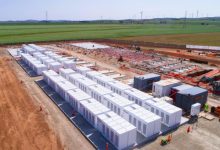The Hornsdale Power Reserve – more commonly known as the Tesla big battery – has set a new record for itself, and the world, in terms of output from a lithium-ion battery, feeding 150MW into the South Australia grid as it continues its complex series of tests.
The injection of 150MW occurred in the 2.25pm trading interval on Tuesday, July 21. It represents the maximum output from the upgraded battery, whose capacity and storage is being expanded from the already world leading 100MW/129MWh to a total of 150MW/194MWh.
 We came across the milestone while checking out the OpenNem widget as we were digging up information for another story, and noticed the patch of blue in the table and graph above.
We came across the milestone while checking out the OpenNem widget as we were digging up information for another story, and noticed the patch of blue in the table and graph above.
And so we checked back on the Hornsdale Power Reserve’s website, and sure enough, there is was. (see chart below)
The expansion of the Hornsdale battery will mean not just greater capacity, but also new services, such as delivering synthetic inertia and “grid-forming” capabilities that are usually the sole province of gas or diesel generators in the local grid.
The expansion of the Hornsdale battery was first announced by its owners, the French-based Neoen, iin November last year, and is being supported by the state government, the Australian Renewable Energy Agency, and the Clean Energy Finance Corporation. It began final testing in June.
As the company says on its web page, the expansion will make Hornsdale Power Reserve 50 per cent bigger and will deliver ground-breaking innovations to increase grid security and further unlock renewable energy performance in South Australia.
The battery has already drawn praise from energy companies, analysts and, most importantly, the Australian Energy Market Operator. So far it has improved grid security and reliability, prevented outages, led to lower costs to consumers, and delivered a handsome return to its owners. And it has also helped map out the path to a renewables-led future for the grid.
See Tesla big battery’s stunning interventions smooths transition to zero carbon grid
In June, a report from Aurecon noted that the Hornsdale Power Reserve had reduced costs in the main grid by $116 million through the provision of Contingency and Regulation Frequency Control Ancillary Services (FCAS), an important grid resource.
In particular, the report noted, thanks to the Hornsdale battery, average Regulation FCAS costs have been reduced by more than 90% (from $470/MWh to $40/MWh), meaning major saving on energy costs in South Australia. As we wrote soon after its initial commissioning, it did not take long to smash the existing gas cartel in that state.
And the report also noted the critical rule in plays in helping prevent catastrophic outcomes in separation events, such as on November 16 last year, and in January this year, when the state was then forced to operate as an “island” for more than two weeks.











